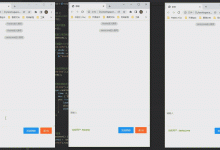前言
以前需要异步执行一个任务时,一般是用Thread或者线程池Executor去创建。如果需要返回值,则是调用Executor.submit获取Future。但是多个线程存在依赖组合,我们又能怎么办?可使用同步组件CountDownLatch、CyclicBarrier等;其实有简单的方法,就是用CompletableFuture
- 线程任务的创建
- 线程任务的串行执行
- 线程任务的并行执行
- 处理任务结果和异常
- 多任务的简单组合
- 取消执行线程任务
- 任务结果的获取和完成与否判断
1、创建异步线程任务
根据supplier创建CompletableFuture任务
//使用内置线程ForkJoinPool.commonPool(),根据supplier构建执行任务public static <U> CompletableFuture<U> supplyAsync(Supplier<U> supplier)//指定自定义线程,根据supplier构建执行任务public static <U> CompletableFuture<U> supplyAsync(Supplier<U> supplier, Executor executor)
根据runnable创建CompletableFuture任务
//使用内置线程ForkJoinPool.commonPool(),根据runnable构建执行任务public static CompletableFuture<Void> runAsync(Runnable runnable)//指定自定义线程,根据runnable构建执行任务public static CompletableFuture<Void> runAsync(Runnable runnable, Executor executor)
- 使用示例
ExecutorService executor = Executors.newSingleThreadExecutor();CompletableFuture<Void> rFuture = CompletableFuture.runAsync(() -> System.out.println(\"hello siting\"), executor);//supplyAsync的使用CompletableFuture<String> future = CompletableFuture.supplyAsync(() -> {System.out.print(\"hello \");return \"siting\";}, executor);//阻塞等待,runAsync 的future 无返回值,输出nullSystem.out.println(rFuture.join());//阻塞等待String name = future.join();System.out.println(name);executor.shutdown(); // 线程池需要关闭--------输出结果--------hello sitingnullhello siting
常量值作为CompletableFuture返回
//有时候是需要构建一个常量的CompletableFuturepublic static <U> CompletableFuture<U> completedFuture(U value)
2 、线程串行执行

任务完成则运行action,不关心上一个任务的结果,无返回值
public CompletableFuture<Void> thenRun(Runnable action)public CompletableFuture<Void> thenRunAsync(Runnable action)public CompletableFuture<Void> thenRunAsync(Runnable action, Executor executor)
- 使用示例
CompletableFuture<Void> future = CompletableFuture.supplyAsync(() -> \"hello siting\", executor).thenRunAsync(() -> System.out.println(\"OK\"), executor);executor.shutdown();--------输出结果--------OK
任务完成则运行action,依赖上一个任务的结果,无返回值
public CompletableFuture<Void> thenAccept(Consumer<? super T> action)public CompletableFuture<Void> thenAcceptAsync(Consumer<? super T> action)public CompletableFuture<Void> thenAcceptAsync(Consumer<? super T> action, Executor executor)
- 使用示例
ExecutorService executor = Executors.newSingleThreadExecutor();CompletableFuture<Void> future = CompletableFuture.supplyAsync(() -> \"hello siting\", executor).thenAcceptAsync(System.out::println, executor);executor.shutdown();--------输出结果--------hello siting
任务完成则运行fn,依赖上一个任务的结果,有返回值
public <U> CompletableFuture<U> thenApply(Function<? super T,? extends U> fn)public <U> CompletableFuture<U> thenApplyAsync(Function<? super T,? extends U> fn)public <U> CompletableFuture<U> thenApplyAsync(Function<? super T,? extends U> fn, Executor executor)
- 使用示例
ExecutorService executor = Executors.newSingleThreadExecutor();CompletableFuture<String> future = CompletableFuture.supplyAsync(() -> \"hello world\", executor).thenApplyAsync(data -> {System.out.println(data); return \"OK\";}, executor);System.out.println(future.join());executor.shutdown();--------输出结果--------hello worldOK
thenCompose – 任务完成则运行fn,依赖上一个任务的结果,有返回值
- 类似thenApply(区别是thenCompose的返回值是CompletionStage,thenApply则是返回 U),提供该方法为了和其他CompletableFuture任务更好地配套组合使用
public <U> CompletableFuture<U> thenCompose(Function<? super T, ? extends CompletionStage<U>> fn)public <U> CompletableFuture<U> thenComposeAsync(Function<? super T, ? extends CompletionStage<U>> fn)public <U> CompletableFuture<U> thenComposeAsync(Function<? super T, ? extends CompletionStage<U>> fn,Executor executor)
- 使用示例
//第一个异步任务,常量任务CompletableFuture<String> f = CompletableFuture.completedFuture(\"OK\");//第二个异步任务ExecutorService executor = Executors.newSingleThreadExecutor();CompletableFuture<String> future = CompletableFuture.supplyAsync(() -> \"hello world\", executor).thenComposeAsync(data -> {System.out.println(data); return f; //使用第一个任务作为返回}, executor);System.out.println(future.join());executor.shutdown();--------输出结果--------hello worldOK
3 、线程并行执行

两个CompletableFuture[并行]执行完,然后执行action,不依赖上两个任务的结果,无返回值
public CompletableFuture<Void> runAfterBoth(CompletionStage<?> other, Runnable action)public CompletableFuture<Void> runAfterBothAsync(CompletionStage<?> other, Runnable action)public CompletableFuture<Void> runAfterBothAsync(CompletionStage<?> other, Runnable action, Executor executor)
- 使用示例
//第一个异步任务,常量任务CompletableFuture<String> first = CompletableFuture.completedFuture(\"hello world\");ExecutorService executor = Executors.newSingleThreadExecutor();CompletableFuture<Void> future = CompletableFuture//第二个异步任务.supplyAsync(() -> \"hello siting\", executor)// () -> System.out.println(\"OK\") 是第三个任务.runAfterBothAsync(first, () -> System.out.println(\"OK\"), executor);executor.shutdown();--------输出结果--------OK
两个CompletableFuture[并行]执行完,然后执行action,依赖上两个任务的结果,无返回值
//第一个任务完成再运行other,fn再依赖消费两个任务的结果,无返回值public <U> CompletableFuture<Void> thenAcceptBoth(CompletionStage<? extends U> other,BiConsumer<? super T, ? super U> action)//两个任务异步完成,fn再依赖消费两个任务的结果,无返回值public <U> CompletableFuture<Void> thenAcceptBothAsync(CompletionStage<? extends U> other,BiConsumer<? super T, ? super U> action)//两个任务异步完成(第二个任务用指定线程池执行),fn再依赖消费两个任务的结果,无返回值public <U> CompletableFuture<Void> thenAcceptBothAsync(CompletionStage<? extends U> other,BiConsumer<? super T, ? super U> action, Executor executor)
- 使用示例
//第一个异步任务,常量任务CompletableFuture<String> first = CompletableFuture.completedFuture(\"hello world\");ExecutorService executor = Executors.newSingleThreadExecutor();CompletableFuture<Void> future = CompletableFuture//第二个异步任务.supplyAsync(() -> \"hello siting\", executor)// (w, s) -> System.out.println(s) 是第三个任务.thenAcceptBothAsync(first, (s, w) -> System.out.println(s), executor);executor.shutdown();--------输出结果--------hello siting
两个CompletableFuture[并行]执行完,然后执行action,依赖上两个任务的结果,有返回值
//第一个任务完成再运行other,fn再依赖消费两个任务的结果,有返回值public <U,V> CompletableFuture<V> thenCombine(CompletionStage<? extends U> other,BiFunction<? super T,? super U,? extends V> fn)//两个任务异步完成,fn再依赖消费两个任务的结果,有返回值public <U,V> CompletableFuture<V> thenCombineAsync(CompletionStage<? extends U> other,BiFunction<? super T,? super U,? extends V> fn)//两个任务异步完成(第二个任务用指定线程池执行),fn再依赖消费两个任务的结果,有返回值public <U,V> CompletableFuture<V> thenCombineAsync(CompletionStage<? extends U> other,BiFunction<? super T,? super U,? extends V> fn, Executor executor)
- 使用示例
//第一个异步任务,常量任务CompletableFuture<String> first = CompletableFuture.completedFuture(\"hello world\");ExecutorService executor = Executors.newSingleThreadExecutor();CompletableFuture<String> future = CompletableFuture//第二个异步任务.supplyAsync(() -> \"hello siting\", executor)// (w, s) -> System.out.println(s) 是第三个任务.thenCombineAsync(first, (s, w) -> {System.out.println(s);return \"OK\";}, executor);System.out.println(future.join());executor.shutdown();--------输出结果--------hello sitingOK
4 、线程并行执行,谁先执行完则谁触发下一任务(二者选其最快)

上一个任务或者other任务完成, 运行action,不依赖前一任务的结果,无返回值
public CompletableFuture<Void> runAfterEither(CompletionStage<?> other, Runnable action)public CompletableFuture<Void> runAfterEitherAsync(CompletionStage<?> other, Runnable action)public CompletableFuture<Void> runAfterEitherAsync(CompletionStage<?> other,Runnable action, Executor executor)
- 使用示例
//第一个异步任务,休眠1秒,保证最晚执行晚CompletableFuture<String> first = CompletableFuture.supplyAsync(()->{try{ Thread.sleep(1000); }catch (Exception e){}System.out.println(\"hello world\");return \"hello world\";});ExecutorService executor = Executors.newSingleThreadExecutor();CompletableFuture<Void> future = CompletableFuture//第二个异步任务.supplyAsync(() ->{System.out.println(\"hello siting\");return \"hello siting\";} , executor)//() -> System.out.println(\"OK\") 是第三个任务.runAfterEitherAsync(first, () -> System.out.println(\"OK\") , executor);executor.shutdown();--------输出结果--------hello sitingOK
上一个任务或者other任务完成, 运行action,依赖最先完成任务的结果,无返回值
public CompletableFuture<Void> acceptEither(CompletionStage<? extends T> other,Consumer<? super T> action)public CompletableFuture<Void> acceptEitherAsync(CompletionStage<? extends T> other,Consumer<? super T> action, Executor executor)public CompletableFuture<Void> acceptEitherAsync(CompletionStage<? extends T> other,Consumer<? super T> action, Executor executor)
- 使用示例
//第一个异步任务,休眠1秒,保证最晚执行晚CompletableFuture<String> first = CompletableFuture.supplyAsync(()->{try{ Thread.sleep(1000); }catch (Exception e){}return \"hello world\";});ExecutorService executor = Executors.newSingleThreadExecutor();CompletableFuture<Void> future = CompletableFuture//第二个异步任务.supplyAsync(() -> \"hello siting\", executor)// data -> System.out.println(data) 是第三个任务.acceptEitherAsync(first, data -> System.out.println(data) , executor);executor.shutdown();--------输出结果--------hello siting
上一个任务或者other任务完成, 运行fn,依赖最先完成任务的结果,有返回值
public <U> CompletableFuture<U> applyToEither(CompletionStage<? extends T> other,Function<? super T, U> fn)public <U> CompletableFuture<U> applyToEitherAsync(CompletionStage<? extends T> other,Function<? super T, U> fn)public <U> CompletableFuture<U> applyToEitherAsync(CompletionStage<? extends T> other,Function<? super T, U> fn, Executor executor)
- 使用示例
//第一个异步任务,休眠1秒,保证最晚执行晚CompletableFuture<String> first = CompletableFuture.supplyAsync(()->{try{ Thread.sleep(1000); }catch (Exception e){}return \"hello world\";});ExecutorService executor = Executors.newSingleThreadExecutor();CompletableFuture<String> future = CompletableFuture//第二个异步任务.supplyAsync(() -> \"hello siting\", executor)// data -> System.out.println(data) 是第三个任务.applyToEitherAsync(first, data -> {System.out.println(data);return \"OK\";} , executor);System.out.println(future);executor.shutdown();--------输出结果--------hello sitingOK
5 、处理任务结果或者异常
exceptionally-处理异常

public CompletableFuture<T> exceptionally(Function<Throwable, ? extends T> fn)
- 如果之前的处理环节有异常问题,则会触发exceptionally的调用相当于 try…catch
- 使用示例
CompletableFuture<Integer> first = CompletableFuture.supplyAsync(() -> {if (true) {throw new RuntimeException(\"main error!\");}return \"hello world\";}).thenApply(data -> 1).exceptionally(e -> {e.printStackTrace(); // 异常捕捉处理,前面两个处理环节的日常都能捕获return 0;});
handle-任务完成或者异常时运行fn,返回值为fn的返回
- 相比exceptionally而言,即可处理上一环节的异常也可以处理其正常返回值
public <U> CompletableFuture<U> handle(BiFunction<? super T, Throwable, ? extends U> fn)public <U> CompletableFuture<U> handleAsync(BiFunction<? super T, Throwable, ? extends U> fn)public <U> CompletableFuture<U> handleAsync(BiFunction<? super T, Throwable, ? extends U> fn,Executor executor)
- 使用示例
CompletableFuture<Integer> first = CompletableFuture.supplyAsync(() -> {if (true) { throw new RuntimeException(\"main error!\"); }return \"hello world\";}).thenApply(data -> 1).handleAsync((data,e) -> {e.printStackTrace(); // 异常捕捉处理return data;});System.out.println(first.join());--------输出结果--------java.util.concurrent.CompletionException: java.lang.RuntimeException: main error!... 5 morenull
whenComplete-任务完成或者异常时运行action,有返回值
- whenComplete与handle的区别在于,它不参与返回结果的处理,把它当成监听器即可
- 即使异常被处理,在CompletableFuture外层,异常也会再次复现
- 使用whenCompleteAsync时,返回结果则需要考虑多线程操作问题,毕竟会出现两个线程同时操作一个结果
public CompletableFuture<T> whenComplete(BiConsumer<? super T, ? super Throwable> action)public CompletableFuture<T> whenCompleteAsync(BiConsumer<? super T, ? super Throwable> action)public CompletableFuture<T> whenCompleteAsync(BiConsumer<? super T, ? super Throwable> action,Executor executor)
- 使用示例
CompletableFuture<AtomicBoolean> first = CompletableFuture.supplyAsync(() -> {if (true) { throw new RuntimeException(\"main error!\"); }return \"hello world\";}).thenApply(data -> new AtomicBoolean(false)).whenCompleteAsync((data,e) -> {//异常捕捉处理, 但是异常还是会在外层复现System.out.println(e.getMessage());});first.join();--------输出结果--------java.lang.RuntimeException: main error!Exception in thread \"main\" java.util.concurrent.CompletionException: java.lang.RuntimeException: main error!... 5 more
6 、多个任务的简单组合
public static CompletableFuture<Void> allOf(CompletableFuture<?>... cfs)public static CompletableFuture<Object> anyOf(CompletableFuture<?>... cfs)


- 使用示例
CompletableFuture<Void> future = CompletableFuture.allOf(CompletableFuture.completedFuture(\"A\"),CompletableFuture.completedFuture(\"B\"));//全部任务都需要执行完future.join();CompletableFuture<Object> future2 = CompletableFuture.anyOf(CompletableFuture.completedFuture(\"C\"),CompletableFuture.completedFuture(\"D\"));//其中一个任务行完即可future2.join();
7、取消执行线程任务
// mayInterruptIfRunning 无影响;如果任务未完成,则返回异常public boolean cancel(boolean mayInterruptIfRunning)//任务是否取消public boolean isCancelled()
- 使用示例
CompletableFuture<Integer> future = CompletableFuture.supplyAsync(() -> {try { Thread.sleep(1000); } catch (Exception e) { }return \"hello world\";}).thenApply(data -> 1);System.out.println(\"任务取消前:\" + future.isCancelled());// 如果任务未完成,则返回异常,需要对使用exceptionally,handle 对结果处理future.cancel(true);System.out.println(\"任务取消后:\" + future.isCancelled());future = future.exceptionally(e -> {e.printStackTrace();return 0;});System.out.println(future.join());--------输出结果--------任务取消前:false任务取消后:truejava.util.concurrent.CancellationExceptionat java.util.concurrent.CompletableFuture.cancel(CompletableFuture.java:2276)at Test.main(Test.java:25)0
8、任务的获取和完成与否判断
// 任务是否执行完成public boolean isDone()//阻塞等待 获取返回值public T join()// 阻塞等待 获取返回值,区别是get需要返回受检异常public T get()//等待阻塞一段时间,并获取返回值public T get(long timeout, TimeUnit unit)//未完成则返回指定valuepublic T getNow(T valueIfAbsent)//未完成,使用value作为任务执行的结果,任务结束。需要future.get获取public boolean complete(T value)//未完成,则是异常调用,返回异常结果,任务结束public boolean completeExceptionally(Throwable ex)//判断任务是否因发生异常结束的public boolean isCompletedExceptionally()//强制地将返回值设置为value,无论该之前任务是否完成;类似completepublic void obtrudeValue(T value)//强制地让异常抛出,异常返回,无论该之前任务是否完成;类似completeExceptionallypublic void obtrudeException(Throwable ex)
- 使用示例
CompletableFuture<Integer> future = CompletableFuture.supplyAsync(() -> {try { Thread.sleep(1000); } catch (Exception e) { }return \"hello world\";}).thenApply(data -> 1);System.out.println(\"任务完成前:\" + future.isDone());future.complete(10);System.out.println(\"任务完成后:\" + future.join());--------输出结果--------任务完成前:false任务完成后:10
总结
Java 多线程一直是面试时候的重点,也是能力提升的重要体现,如何做到波澜不惊,从容面对,需要我们对其中的内容融汇贯通,小编这里也对应总结了一份多线程-并发编程的思维导图,需要的朋友可以看看,关注公众号:麒麟改bug,还可以领取一份包含了Java基础、Java集合容器、Java异常、并发编程、JVM、Spring、Spring MVC、Spring Boot、Spring Cloud、MyBatis、Redis、MySQL数据库、消息中间件MQ与RabbitMQ、Dubbo、Linux、Tomcat、ZooKeeper、Netty、 架构设计&分布式&数据结构与算法等等,都是互联网大厂的面试真题,已经有粉丝靠这份PDF拿下众多大厂的offer。

 爱站程序员基地
爱站程序员基地


